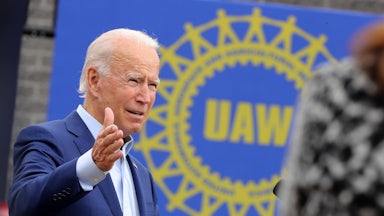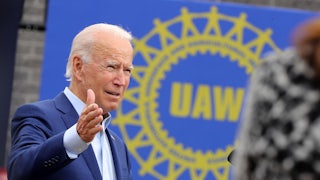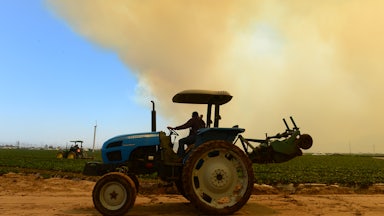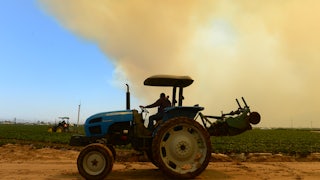When a group of California farm owners in the San Joaquin Valley sought to stop union organizers from speaking with workers on their farms in 1975, they authorized an armed right-wing militia called the San Joaquin Valley Posse Comitatus organization to block entry. “On a pickup truck emblazoned with a bumper sticker reading ‘God, Guns and Guts Made U.S. Free,’ was a stack of ‘citizen’s arrest forms,’ which [the organization’s leader] indicated he would utilize if any union workers attempted to pass,” The New York Times reported at the time.
Nearly five decades later, California farm owners asked the Supreme Court to do one better than the armed extremists they once conscripted. In a 6–3 decision on Wednesday, the court’s conservative bloc delivered, striking down a California agricultural rule that allowed union representatives to speak with workers for certain periods of time each year on the farms themselves. Chief Justice John Roberts, writing for the majority, concluded that the rule amounted to an uncompensated “taking,” in violation of the Fifth Amendment.
“The access regulation appropriates a right to invade the growers’ property and therefore constitutes a per se physical taking,” Roberts wrote for the court. “The regulation grants union organizers a right to physically enter and occupy the growers’ land for three hours per day, 120 days per year. Rather than restraining the growers’ use of their own property, the regulation appropriates for the enjoyment of third parties the owners’ right to exclude.”
Wednesday’s ruling is a major defeat for California farmworkers and their unions—and, accordingly, a resounding victory for the state’s massive agribusiness industry. But the decision’s ramifications could spread beyond making it harder for farmworkers to organize in California. By accepting the farm owners’ Takings Clause reasoning, the court also opened the door to an extreme theory that could upend a wide swath of basic government regulations.
The case, Cedar Point Nursery v. Hassid, stems from a dispute between two California farms and the United Farm Workers. After Cedar Point Nursery and Fowler Packing Company clashed with the union over its organizing tactics in 2015, both farms sued the state’s Agricultural Labor Relations Board, or CALRB, represented by its chair, Victoria Hassid. They sought to block a long-standing CALRB rule that allowed union organizers to be on the company’s land for three hours a day for 120 days each year for organizing purposes. A federal district court and the Ninth Circuit Court of Appeals rejected their bid to overturn the access rule.
California labor regulators adopted the rule in 1975 as part of the state’s sweeping agricultural labor reforms in the mid-1970s, which sought to end years of unrest. The access rule sought to address the unusual challenges that came with organizing California’s multilingual and migratory farmworkers. In a friend-of-the-court brief, the United Farm Workers estimated that more than 117,000 farmworkers in California currently come from Indigenous communities that don’t speak English or Spanish. They often lack permanent addresses and sometimes don’t even own cell phones. “Given these conditions, face-to-face access at the worksite is not only the most effective way of communicating with farmworkers about their labor rights—practically speaking, it is the only way to do so,” the UFW told the court.
The farm owners acknowledged past legal precedents that allowed organizers onto their property but argued that those precedents only applied when the workers also lived on the property itself, which would make them largely inaccessible under normal means. They argued that the intrusions represented a “per se” taking, a legal term usually applied to severe government actions that permanently deprive someone of their property rights in some way. Under the Fifth Amendment’s Takings Clause, the government can’t take private property “for public use without just compensation.”
“The uncompensated appropriation of an interest in real property is sufficient on its own to establish a physical taking,” the farm owners argued in their brief for the court. “That the property interest taken in this case is an easement only makes the discrete property interest more obvious, as this Court has consistently held that the government must always provide just compensation for the taking of an easement. That holds true even where an easement does not authorize around-the-clock access.”
The board strenuously disputed this interpretation, arguing that the rule’s burden upon the farm owners was nowhere near that severe or long-lasting. “The board’s access regulation is not remotely equivalent to those per se takings,” the board wrote in its brief for the court. “It strictly limits who may access the property of agricultural employers, when they may do so, for what purpose, and in what manner. While the regulation may interfere with property owners’ right to exclude certain organizers for the brief periods of authorized access, it is not comparable to a permanent physical occupation.”
More importantly, however, the board also warned of the possible implications of the farm owners’ view of the Takings Clause. “The categorical rules proposed by [the farm owners] and [in friend-of-the-court briefs] would also imperil a wide variety of health- and safety-inspection regimes,” the board told the court. “These include, among many others, food and drug inspections, occupational safety and health inspections, and home visits by social workers. For more than a century, courts have rejected Takings Clause challenges to inspection regimes of this nature.”
The CALRB noted that many federal and state regulations call for regular visits by government inspectors to ensure compliance, sometimes without warning or notice. They also pointed to laws that envisioned third parties to participate in these inspections, such as federal laws that allow union representatives to accompany mine inspectors. “While some inspection regimes might be justified as reasonable conditions on a government-issued license, others exist independent of any licensing or permitting scheme,” the board wrote.
Invoking the Takings Clause to resist regulations is a familiar theme in American legal history. Some of the attempts involved deeply unsavory plaintiffs. Nikolas Bowie, a Harvard University law professor, noted in March that the Supreme Court had unanimously rejected such a claim in Heart of Atlanta Motel v. United States, where the justices upheld the constitutionality of anti-discrimination provisions in the Civil Rights Act of 1964. “No doubt muffling its laughter, the Supreme Court responded simply, ‘The cases are to the contrary,’” Bowie wrote. “The cases it cited interpreted the Fifth Amendment to require ‘just compensation’ only for literal seizures of land.”
These concerns were not enough for Roberts and the other five conservative justices to reject the farm owners’ interpretation of the court’s previous rulings. “The upshot of this line of precedent is that government-authorized invasions of property—whether by plane, boat, cable, or beachcomber—are physical takings requiring just compensation,” the chief justice wrote. “As in those cases, the government here has appropriated a right of access to the growers’ property, allowing union organizers to traverse it at will for three hours a day, 120 days a year.”
But, perhaps in recognition of the dangers of such a sweeping view of the Takings Clause, the court also tried to blunt the impact of its own decision. Roberts distinguished between takings and trespass, suggesting that “isolated physical invasions” would not require the government to compensate the property owner. He also noted that “many government-authorized physical invasions will not amount to takings because they are consistent with longstanding background restrictions on property rights,” such as nuisance abatement. Warrants that comply with the Fourth Amendment wouldn’t count as a taking, Roberts added, nor would inspections that were required to obtain a health and safety license of some sort.
Justice Stephen Breyer was unpersuaded by Roberts’s reasoning. “It is important to understand, however, that, technically speaking, the majority is wrong,” he wrote in a dissenting opinion joined by Justices Sonia Sotomayor and Elena Kagan. “The regulation does not appropriate anything. It does not take from the owners a right to invade (whatever that might mean). It does not give the union organizations the right to exclude anyone. It does not give the government the right to exclude anyone. What does it do? It gives union organizers the right temporarily to invade a portion of the property owners’ land. It thereby limits the landowners’ right to exclude certain others. The regulation regulates (but does not appropriate) the owners’ right to exclude.”
That seems fairly straightforward. He went on to note that many of those purported limits will only invite further litigation—what counts as an “isolated physical invasion” seems like an obvious one—and could prove to be less substantive than the majority suggests. “In my view, the majority’s conclusion threatens to make many ordinary forms of regulation unusually complex or impractical,” Breyer wrote. “And though the majority attempts to create exceptions to narrow its rule, the law’s need for feasibility suggests that the majority’s framework is wrong.”
Perhaps the most revealing part of Wednesday’s opinion, however, comes at the end of Breyer’s own dissent. “Finally, I touch briefly on remedies, which the majority does not address,” he wrote. “The Takings Clause prohibits the Government from taking private property for public use without ‘just compensation.’ But the employers do not seek compensation. They seek only injunctive and declaratory relief. Indeed, they did not allege any damages. On remand, California should have the choice of foreclosing injunctive relief by providing compensation.”
It’s worth underscoring the point that Breyer made here, whether intentionally or not. When you file a lawsuit, you generally need an injury of some kind as well as a remedy that the court can provide. This often means money. If someone hits you with their car in a crosswalk, you could sue to get them to pay your medical bills. If you place an order for a product and don’t receive it, you can sue the company for a refund. These are the fairly basic mechanics of the American legal system.
But the farm owners, as Breyer noted, did not actually seek payment of any kind from the board in their lawsuit. They invoked the Fifth Amendment’s promise of “just compensation” but didn’t actually ask for any. They only sought an injunction to stop the underlying regulation from happening again. For all the high-minded discussions of property rights and government usurpations, the actual issue here is pretty straightforward: The farm owners don’t want their workers to organize, and they’ll embrace any plausible legal theory that could persuade the courts to make it harder for unions to do so.
In a way, it’s hard to blame them. The court’s conservative majority has long signaled its willingness to tear down pro-union legal precedents and chip away at the modern regulatory state. And while the justices have moved slower on some right-wing ideological priorities than others, they have shown no reticence whatsoever about shifting the balance between labor and capital in the latter’s favor. The farm owners’ strategy worked this time, and if Wednesday’s ruling is any indication, it could do so again soon.








